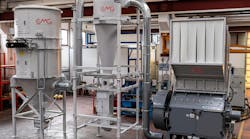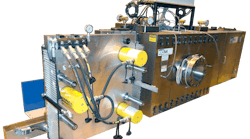By Ron Shinn
Developing a new airplane or drug or medical implant is a long and arduous task, but you would think bringing to market a railroad tie made from recycled plastic resin and glass reinforcing fiber could happen in a snap.
Not so, according to Tim Noonan, founder and CEO of Evertrak LLC in St. Louis. He launched the company seven years ago and in 2018 started intensive development of a composite railroad tie that is now being delivered to customers.
“We looked at the failed innovations of the past 25 years and we saw a fallacy,” Noonan said. “Others heard customers say, ‘We want a tie that is as cheap as wood.’ Our insight was that our customers actually needed a tie that is as strong as wood.
“We set out to make a railroad tie that is engineered to be as strong as a wooden railroad tie,” Noonan said. “This shifts the discussion from price to value, or total cost of ownership over the life of the tie. We also help our customers meet sustainability goals without a tradeoff of the business case.”
A 220-pound plastic composite railroad tie might sound like a low-tech product, but, to get it to market, like Evertrak had to perform extensive development of the material recipe, working out the manufacturing process and convincing railroads to test the ties. The testing phase takes years, first with internal testing, then through federal government testing partnerships and finally with each customer.
Evertrak now has about 100,000 ties installed in North America and Noonan said the company has a 10-month backlog of orders. He expects Evertrak to produce about 100,000 ties this year, and there is space in the current location to expand to about 300,000 per year. The current plant covers 85,000 square feet.
The company has 32 employees and works three shifts, five days per week.
Industry estimates are approximately 20 million to 25 million standard railroad ties need to be replaced every year, so the potential market is huge. There are more than 600 freight railroad companies running on about 140,000 miles of track in North America.
Traditional wood ties manufactured from old-growth hardwood can degrade in as little as five years in humid areas. Wood ties are generally soaked in creosote, which has been found to cause cancer. Additionally, old-growth hardwood is becoming scarce.
“Our mantra is now ‘Solidify and separate,’ ” Noonan said. “Solidify all that we have learned, not only in our manufacturing process but more importantly in our culture, and separate our product from the failed innovations of the past to build customer trust.”
Financially, Evertrak has turned a corner. “We are cash-flowing and profitable and meeting all of our commitments,” Noonan said. “We intend to invest to improve quality and deliver value to our customers.”
Manufacturing ties
Evertrak buys recycled high-density polyethylene and polypropylene flake and mixes them with glass fiber from Owens Corning, an Evertrak partner. The mixture is blended, then run through a single-screw Davis-Standard extruder.
Noonan said they worked with Owens Corning to develop an extrusion process that maintains the length over diameter (L/D) of the glass fiber. This provides reinforcing strength. “We’re able to maintain very good L/D, so we are not concerned about that.”
The 400-degree extruded material is cast into a conformal shape and cools for a couple of hours before being taken out of the mold.
“The thermal load inside of the tie is very high,” Noonan said. “The outer shell is an insulator. When it is extracted, the tie is still warm on the inside.”
Every tie goes through numerous quality checks, including X-ray that identifies voids caused by gassing during the extrusion process. Ties that do not meet quality standards are rejected and can be reused in future ties.
Before final inspection, ties go through a texturing station to create grip when installed in the granite rock roadbed.
Finished ties are shipped to customers via rail.
“As we continue to sharpen our process through continuous improvement, we will reduce inefficiencies, increase quality, maintain safety and reduce costs that we can pass on to our customers,” Noonan said.
Some buyers ask for Evertrak to deliver their ties pre-plated. The plate attaches the rail to the tie. The process involves drilling holes and attaching the plate with spikes. Other railroads do not request pre-plating because they have machines that hammer the spikes into the ties as they are used.
Composite ties weigh about the same as wood ties, are installed the same way and can be interspersed with wood ties.
The value proposition
Overcoming negative perceptions stemming from the poor performance of earlier recycled plastic ties has been a chore for Evertrak. After installing its first ties at the federal government’s test track in 2018, Evertrak started receiving “very small, very small orders for ties — orders for hundreds and low thousands,” for testing, Noonan said.
“You can give the railroads all the test data you want, but they want to install and run the ties through their own tests,” he said.
Union Pacific, the largest railroad company in the U.S., has tested Evertrak ties in Little Rock, Ark.; St. Louis; Fort Worth, Texas; and Reno, Nev. While Evertrak does not comment on how long its ties will last, the railroad said in a press release that its criteria for composite ties is that they last 50 years. Union Pacific also said it plans to double the number of composite ties it installs in 2024.
Union Pacific also said it believes composite ties, which it is using in areas where traditional wooden ties need to be replaced every eight to 15 years because of rot, improve the railroad’s infrastructure and reduce its climate impact.
Noonan said that the Evertrak tie outperforms the industry standard for composite ties as measured by modulus of rupture (MOR). Evertrak’s tie received the American Association of Railroad’s quality certification M-1003, the equivalent of ISO-9001.
Evertrak’s tie, available in lengths from 8 feet 6 inches, to 10 feet, is called the Evertrak 7000. The number 7000 designates an MOR of 7,000 PSI, nearly three times the industry standard and equivalent to wood.
“We have focused ruthlessly on making only a standard railroad tie,” Noonan said. “We haven’t spent a lot of money on marketing or other overhead costs. We have a very lean leadership team who work with our team on the front line. Our overhead is very, very low.”
Noonan, a former Marine Corps officer and Boeing retiree, is proud that the company is veteran-owned and that a large majority of his employees are formerly incarcerated and homeless citizens. “We pay a living wage, we have full benefits, including a 401(k) matching program, and we pay above industry premiums for health care,” he said.
“We are really proud that we are able to work at the friction point in society and meet people where they are. We don’t judge people by the worst moments in their lives,” he said.
Employees appreciate that they are making a product that keeps plastic out of the oceans and may last 100 years. “We feel very connected to the idea that in our own tiny way, we are making a difference in the world,” Noonan said.
Resin supply
Evertrak currently sources both post-industrial and post-consumer resin from all over the U.S. and Canada. Noonan said he does not foresee a problem finding resin as the company scales up production. “I am confident that we have line-of-sight in our supply chain for plastic that scales up to hundreds of thousands of ties a year.”
There is a disposal cost for creosote-soaked wood ties that are taken out of service, but not Evertrak’s composite ties, which are recyclable. “Evertrak ties become an asset, not a liability,” Noonan said.
“We are going to sequester millions of pounds of plastic. In the future, innovation is going to create a process to use that carbon for something else,” Noonan said. “The railroads are building a plastic mine.”
Contact:
Evertrak LLC, St. Louis, 314-463-0999, www.evertrak.com






